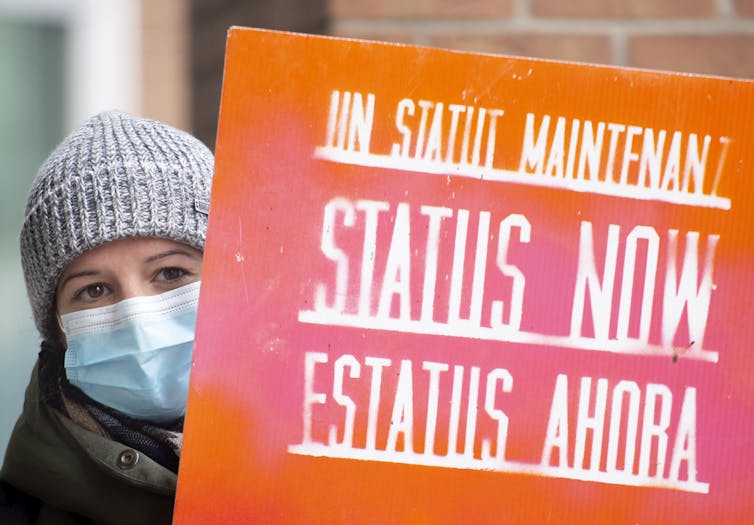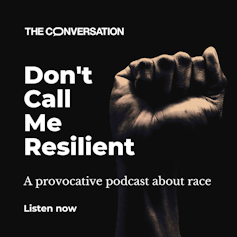
Luin Goldring, York University, Canada and Patricia Landolt, University of Toronto
Migrant rights networks, advocates and allies in Canada are calling for status for all. And this call is not new. It is time to ask why status for all is essential for mitigating social inequalities laid bare by the pandemic.
Status for all means permanent residency for all temporary migrant workers and their families who live in Canada with precarious legal status. Temporary migrant workers include international students, refugee claimants, temporary foreign workers in low-wage occupations and migrants classified as high-skilled in the International Mobility Program. It also includes non-status migrants.
Read more: Coronavirus: Canada stigmatizes, jeopardizes essential migrant workers
In December 2020, there were over a million temporary migrants in Canada, including international students and low- and high-wage temporary migrant workers. There were also 81,000 or more refugee claimants. But there is no reliable data on how many people live and work in Canada without authorization.
They all have precarious legal status, which makes their vulnerability distinct. All temporary migrants are deportable.
There are legal limits set on their access to work, health care and education. And they must constantly meet formal and unspoken conditions to remain in Canada and access work.
Most have limited access to government supports, including COVID-19 income supports: international students were entitled to CERB but didn’t always qualify.
With the pandemic, pathways to permanent residence (PR) have been disrupted, put on hold, restarted and modified — leaving many migrants in indefinite temporariness.
How did we get here?
Two decades ago, the government of Canada moved towards a two-track, two-step immigration system that prioritizes the temporary migration of people with precarious legal status.
Three features of the new system ensure migrant vulnerability in the labour market, which continually reproduces conditions that guarantee an ongoing pool of people who live and work in Canada without status.
First, employer-driven selection and probation are central to the new immigration system. The two-step model allows some foreign worker categories and international students to apply for PR after meeting work-centred requirements and gives employers and provinces a larger role in selecting and retaining migrant workers and immigrants. As a result, employers are in control of many migrant workers’ access to work and PR.
The financial and political gutting of refugee determination is a second component of the system. Concerns over dangerous and “bogus” refugees claimants led to changes in the system that restrict access, create backlogs, provide insufficient social assistance and force people to choose survival jobs over education and training.
Third, the immigration system reproduces the non-status population. Temporary migrants can fall out of status when they navigate complex and changing policies and requirements. These can include being unable to afford the fees for tests and permit renewals, relationship breakdowns, and if they leave a job for any reason such as unpaid wages, sexual harassment, or unsafe working conditions. They are subject to surveillance and fear of deportation in their encounters with almost everyone.
This can make international students, refugee claimants, temporary migrant workers and non-status people feel like they are navigating a game of chutes and ladders.
These situations breed anxiety and uncertainty. Spending time with temporary status or without status has lasting impacts. It affects physical and mental health, family dynamics and long-range planning.
Pre-pandemic life was already uncertain for many, and it has made things worse financially and emotionally. A way to resolve this is by ensuring that the barrier of precarious status is removed for all.
Renewing the call: Status for all
A year into the pandemic, migrants and advocates are calling for status for all. Regularization strategies have been reviewed and proposed, and there are other proposals and programs in the works.
One approach hinges on the motto “good enough to work, good enough to stay.” It extends employer control because it links the granting of PR to employment criteria. It includes proposals to expedite the transition to PR for temporary workers and international students and government pilot status adjustment programs.
A government program rewards “deserving” workers in long-term care homes with pending or denied refugee claims with a path to PR. Another program offers a path for agri-food workers with 12 months of non-seasonal temporary work permit experience who meet language requirements and have an offer for non-seasonal employment. A third will give PR to up to 500 previously authorized, but currently non-status construction workers in the GTA and their families. And a recently announced new program will give PR to over 90,000 essential temporary workers and international graduates.
While these are paths forward, they aren’t perfect. Employment-based regularization is short-term, strategic and pragmatic. It focuses on migrant workers with higher human capital, but largely leaves out refugee claimants, those without status, youth and non-working family members. The government’s pilot programs are a drop in the bucket. Most migrant workers, asylum claimants, international students and people without status will be left out.
Status for all centres human rights, mobility rights and decent work — for all temporary migrants with precarious legal status and their families, not just workers in some sectors or occupations.
Status for all can contribute to decent work by eliminating temporariness and illegalization as grounds for exploitation and harassment and can better migrants’ health and well-being. PR will not remove racism and other systemic barriers, but it is crucial. With greater security and less fear, immigrants with secure status can focus time and resources on their families and communities.

Post-pandemic immigration policy is a longer conversation that must consider the global dimensions of migration. We can work toward an equitable recovery by acknowledging the systemic failures of the Canadian immigration system. It begins with reversing the rise of two-track and two-step immigration and prioritizing permanent immigration.
Francisco Rico-Martinez, co-director of the FCJ Refugee Centre, contributed to this piece.
Luin Goldring, Professor of Sociology, York University, Canada and Patricia Landolt, Professor of Sociology, University of Toronto
This article is republished from The Conversation under a Creative Commons license. Read the original article.



